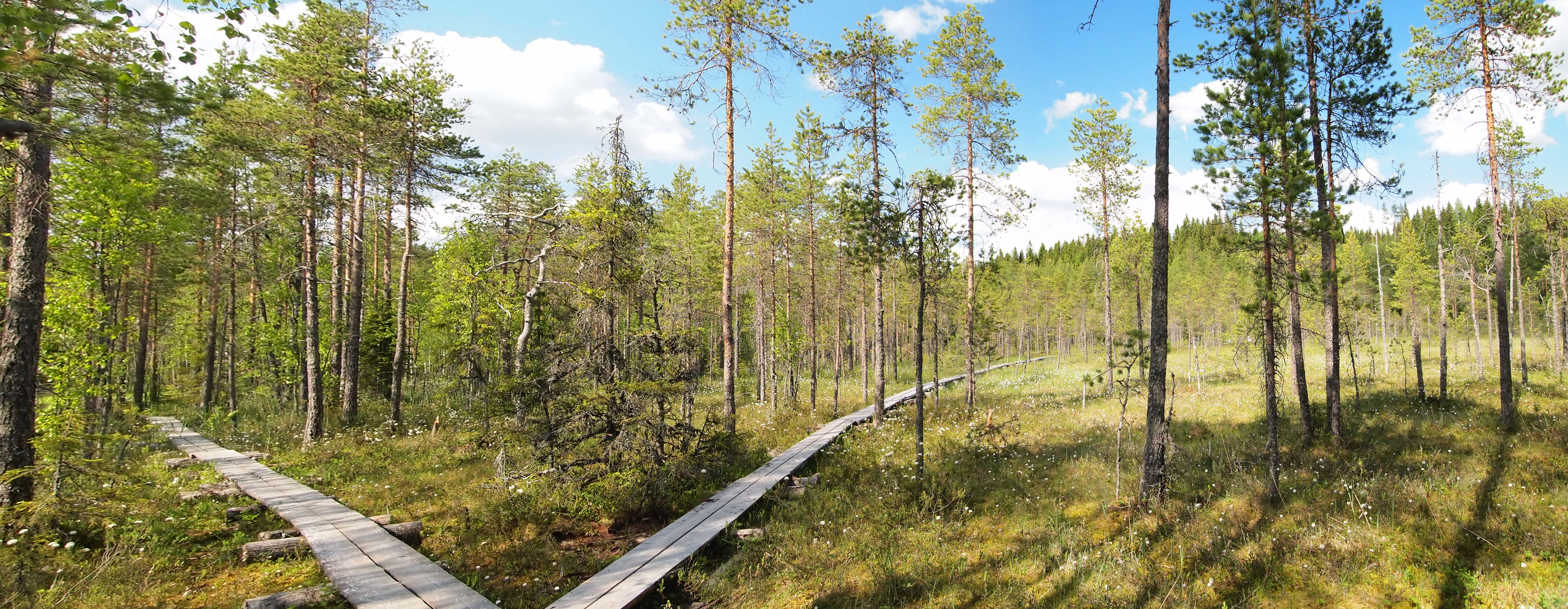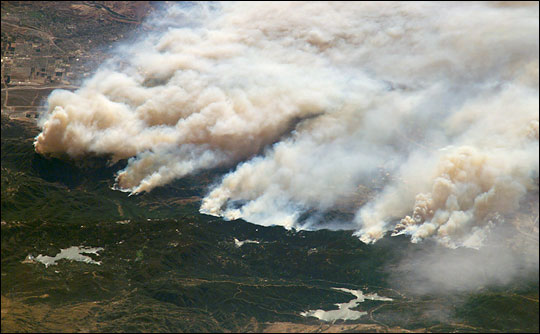|
Huffman Prairie
Huffman Prairie, also known as Huffman Prairie Flying Field or Huffman Field is part of Ohio's Dayton Aviation Heritage National Historical Park. The 84-acre (34-hectare) patch of rough pasture, near Fairborn, northeast of Dayton, is the place where the Wright brothers ( Wilbur and Orville) undertook the difficult and sometimes dangerous task of creating a dependable, fully controllable airplane and training themselves to be pilots. Many early aircraft records were set by the Wrights at the Huffman Prairie. History The Wrights began using Huffman Prairie in 1904 with the permission of the field's owner, Dayton banker Torrence Huffman. It was located near an interurban trolley stop called Simms Station, outside the brothers' hometown of Dayton. In April, they started testing their Wright Flyer II. The Wrights made about 150 flights at the field in 1904–1905, leading to development of the 1905 Wright Flyer III, which they considered to be the first practical airplane. Th ... [...More Info...] [...Related Items...] OR: [Wikipedia] [Google] [Baidu] |
Fairborn, Ohio
Fairborn is a city in Greene County, Ohio, United States. The population was 34,620 at the 2020 census. Fairborn is a suburb of Dayton, and part of the Dayton Metropolitan Statistical Area. It is the only city in the world named Fairborn, a portmanteau created from the names Fairfield and Osborn. After the Great Dayton Flood of 1913, the region and state created a conservation district here and, in the 1920s, began building Huffman Dam to control the Mad River. Residents of Osborn were moved with their houses to an area alongside Fairfield. In 1950, the two villages merged into the new city of Fairborn. The city is home to Wright State University, which serves nearly 12,000 undergraduate and graduate students. The city also hosts the disaster training facility known informally as National Center for Medical Readiness, Calamityville. History Fairborn was formed from the union in 1950 of the two villages of Fairfield and Osborn. Fairfield was founded by European Americans in 18 ... [...More Info...] [...Related Items...] OR: [Wikipedia] [Google] [Baidu] |
Wright Exhibition Team
The Wright Exhibition Team was a group of early aviators trained by the Wright brothers at Wright Flying School in Montgomery, Alabama in March 1910. History The group was formed in 1910 at the suggestion of balloonist Augustus Roy Knabenshue. The team made its first public appearance on June 13, 1910 at the Indianapolis Motor Speedway. The team performed aerial shows and set records for altitude ''(4939 feet)'' and endurance. Pilots were paid $20 per week and $50 a day when flying. By August there were five separate teams flying at one time with $186,000 in receipts. Ralph Johnstone was the first to be killed. After attempting another altitude record over Denver's Overland Park in November, Johnstone put his plane into Walter Richard Brookins' 'spiral dip' dive, and he never recovered. The plane plummeted to the ground, and Johnstone was crushed. A month later, on New Year's Eve, 1910, Arch Hoxsey was killed in an identical crash. Although the team had lost its star flier ... [...More Info...] [...Related Items...] OR: [Wikipedia] [Google] [Baidu] |
World Heritage
A World Heritage Site is a landmark or area with legal protection by an international convention administered by the United Nations Educational, Scientific and Cultural Organization (UNESCO). World Heritage Sites are designated by UNESCO for having cultural, historical, scientific or other form of significance. The sites are judged to contain "cultural and natural heritage around the world considered to be of outstanding value to humanity". To be selected, a World Heritage Site must be a somehow unique landmark which is geographically and historically identifiable and has special cultural or physical significance. For example, World Heritage Sites might be ancient ruins or historical structures, buildings, cities, deserts, forests, islands, lakes, monuments, mountains, or wilderness areas. A World Heritage Site may signify a remarkable accomplishment of humanity, and serve as evidence of our intellectual history on the planet, or it might be a place of great natural beauty. As ... [...More Info...] [...Related Items...] OR: [Wikipedia] [Google] [Baidu] |
National Historic Landmark
A National Historic Landmark (NHL) is a building, district, object, site, or structure that is officially recognized by the United States government for its outstanding historical significance. Only some 2,500 (~3%) of over 90,000 places listed on the country's National Register of Historic Places are recognized as National Historic Landmarks. A National Historic Landmark District may include contributing properties that are buildings, structures, sites or objects, and it may include non-contributing properties. Contributing properties may or may not also be separately listed. Creation of the program Prior to 1935, efforts to preserve cultural heritage of national importance were made by piecemeal efforts of the United States Congress. In 1935, Congress passed the Historic Sites Act, which authorized the Interior Secretary authority to formally record and organize historic properties, and to designate properties as having "national historical significance", and gave the Nation ... [...More Info...] [...Related Items...] OR: [Wikipedia] [Google] [Baidu] |
Runway
According to the International Civil Aviation Organization (ICAO), a runway is a "defined rectangular area on a land aerodrome prepared for the landing and takeoff of aircraft". Runways may be a man-made surface (often asphalt concrete, asphalt, concrete, or a mixture of both) or a natural surface (sod, grass, soil, dirt, gravel, ice, sand or road salt, salt). Runways, as well as taxiways and Airport apron, ramps, are sometimes referred to as "tarmac", though very few runways are built using Tarmacadam, tarmac. Takeoff and landing areas defined on the surface of water for seaplanes are generally referred to as waterways. Runway lengths are now International Civil Aviation Organization#Use of the International System of Units, commonly given in meters worldwide, except in North America where feet are commonly used. History In 1916, in a World War I war effort context, the first concrete-paved runway was built in Clermont-Ferrand in France, allowing local company Michelin to ... [...More Info...] [...Related Items...] OR: [Wikipedia] [Google] [Baidu] |
Shrub
A shrub (often also called a bush) is a small-to-medium-sized perennial woody plant. Unlike herbaceous plants, shrubs have persistent woody stems above the ground. Shrubs can be either deciduous or evergreen. They are distinguished from trees by their multiple stems and shorter height, less than tall. Small shrubs, less than 2 m (6.6 ft) tall are sometimes termed as subshrubs. Many botanical groups have species that are shrubs, and others that are trees and herbaceous plants instead. Some definitions state that a shrub is less than and a tree is over 6 m. Others use as the cut-off point for classification. Many species of tree may not reach this mature height because of hostile less than ideal growing conditions, and resemble a shrub-sized plant. However, such species have the potential to grow taller under the ideal growing conditions for that plant. In terms of longevity, most shrubs fit in a class between perennials and trees; some may only last about five y ... [...More Info...] [...Related Items...] OR: [Wikipedia] [Google] [Baidu] |
Wildflower
A wildflower (or wild flower) is a flower that grows in the wild, meaning it was not intentionally seeded or planted. The term implies that the plant probably is neither a hybrid nor a selected cultivar that is in any way different from the way it appears in the wild as a native plant, even if it is growing where it would not naturally. The term can refer to the flowering plant as a whole, even when not in bloom, and not just the flower. "Wildflower" is not an exact term. More precise terms include ''native species'' (naturally occurring in the area, see flora), ''exotic'' or, better, ''introduced species'' (not naturally occurring in the area), of which some are labelled ''invasive species'' (that out-compete other plants – whether native or not), ''imported'' (introduced to an area whether deliberately or accidentally) and ''naturalized'' (introduced to an area, but now considered by the public as native). In the United Kingdom, the organization Plantlife International in ... [...More Info...] [...Related Items...] OR: [Wikipedia] [Google] [Baidu] |
Nature Trail
An educational trail (or sometimes educational path), nature trail or nature walk is a specially developed hiking trail or footpath that runs through the countryside, along which there are marked stations or stops next to points of natural, technological or cultural interest. These may convey information about, for example, flora and fauna, soil science, geology, mining, ecology or cultural history. Longer trails, that link more widely spaced natural phenomena or structures together, may be referred to as themed trails or paths. In order to give a clearer explanation of the objects located at each station, display boards or other exhibits are usually erected, in keeping with the purpose of the trail. These may include: information boards, photographs and pictures, maps or plans, display cases and models, slides, sound or multimedia devices, facilities to enable experimentation and so on. The routes are regularly maintained. Educational trails with a strong thematic content may a ... [...More Info...] [...Related Items...] OR: [Wikipedia] [Google] [Baidu] |
Fire Ecology
Fire ecology is a scientific discipline concerned with natural processes involving fire in an ecosystem and the ecological effects, the interactions between fire and the abiotic and biotic components of an ecosystem, and the role as an ecosystem process. Many ecosystems, particularly prairie, savanna, chaparral and coniferous forests, have evolved with fire as an essential contributor to habitat vitality and renewal. Many plant species in fire-affected environments require fire to germinate, establish, or to reproduce. Wildfire suppression not only eliminates these species, but also the animals that depend upon them. Campaigns in the United States have historically molded public opinion to believe that wildfires are always harmful to nature. This view is based on the outdated beliefs that ecosystems progress toward an equilibrium and that any disturbance, such as fire, disrupts the harmony of nature. More recent ecological research has shown, however, that fire is an integral com ... [...More Info...] [...Related Items...] OR: [Wikipedia] [Google] [Baidu] |
Tall-grass Prairie
The tallgrass prairie is an ecosystem native to central North America. Historically, natural and anthropogenic fire, as well as grazing by large mammals (primarily bison) provided periodic disturbances to these ecosystems, limiting the encroachment of trees, recycling soil nutrients, and facilitating seed dispersal and germination. Prior to widespread use of the steel plow, which enabled large scale conversion to agricultural land use, tallgrass prairies extended throughout the American Midwest and smaller portions of southern central Canada, from the transitional ecotones out of eastern North American forests, west to a climatic threshold based on precipitation and soils, to the southern reaches of the Flint Hills in Oklahoma, to a transition into forest in Manitoba. They were characteristically found in the central forest-grasslands transition, the central tall grasslands, the upper Midwest forest-savanna transition, and the northern tall grasslands ecoregions. They flour ... [...More Info...] [...Related Items...] OR: [Wikipedia] [Google] [Baidu] |
National Park Service
The National Park Service (NPS) is an agency of the United States federal government within the U.S. Department of the Interior that manages all national parks, most national monuments, and other natural, historical, and recreational properties with various title designations. The U.S. Congress created the agency on August 25, 1916, through the National Park Service Organic Act. It is headquartered in Washington, D.C., within the main headquarters of the Department of the Interior. The NPS employs approximately 20,000 people in 423 individual units covering over 85 million acres in all 50 states, the District of Columbia, and US territories. As of 2019, they had more than 279,000 volunteers. The agency is charged with a dual role of preserving the ecological and historical integrity of the places entrusted to its management while also making them available and accessible for public use and enjoyment. History Yellowstone National Park was created as the first national par ... [...More Info...] [...Related Items...] OR: [Wikipedia] [Google] [Baidu] |

.jpg)







